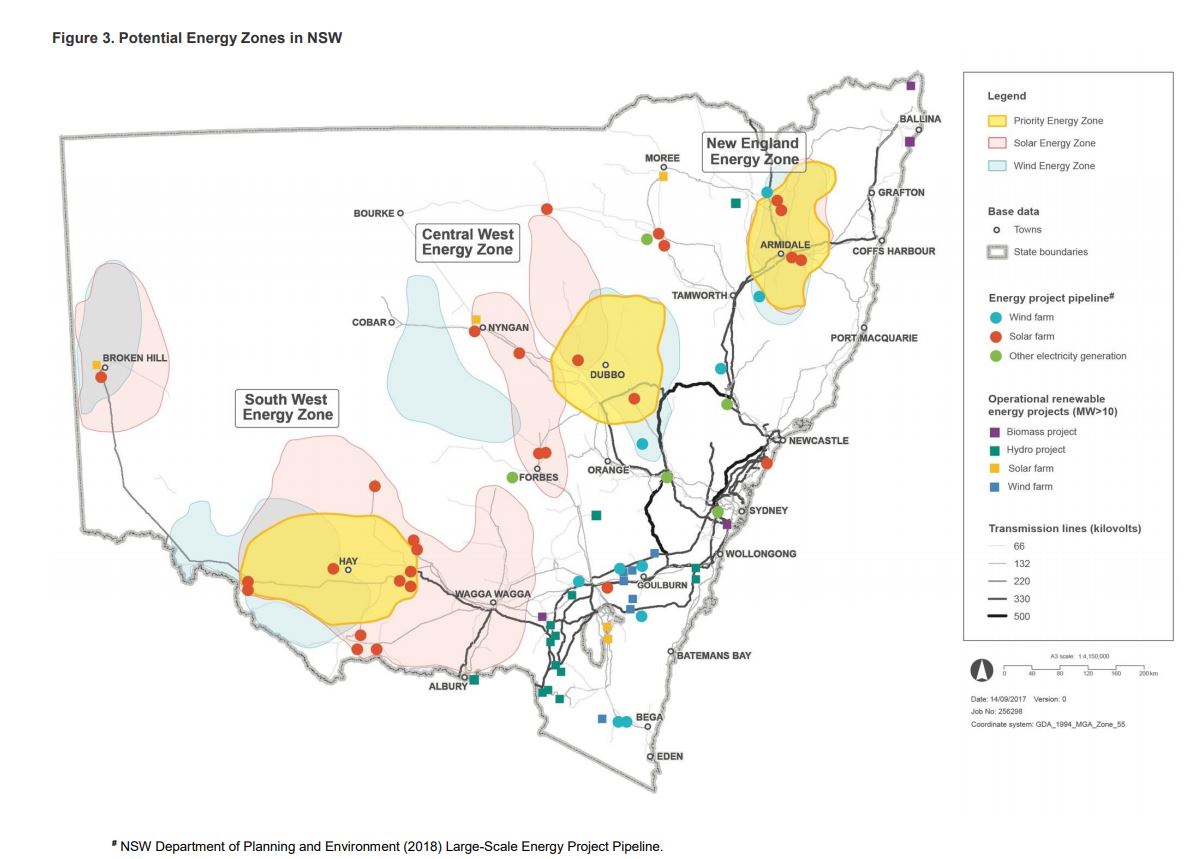“The nine-fold level of interest in the Central-West Orana REZ was astounding, so it makes absolute sense to go even bigger with the New England REZ,” said New South Wales Energy Minister, Matt Kean on Friday in announcing a $79 million plan to develop an 8 GW Renewable Energy Zone, the second Renewable Energy Zone confirmed in the state, in order to soak up that positive developer response sentiment.
The New England REZ, with the northern NSW city of Armidale at its heart, is expected to attract $12.7 billion worth of new projects to the region, providing 2,000 construction jobs and 1,300 ongoing positions, and will have the ability to power 3.5 million homes.
“Our region is fast becoming the renewables capital of NSW and we’re home to some of the best renewable energy resources in the country,” said Adam Marshall, state member for the Northern Tablelands.
The renewables industry is abuzz with excitement and congratulation of the Berejiklian Government and of Kean in particular, who has laid important groundwork for transitioning the state towards renewables, since taking on the Energy portfolio in the wake of the Liberal-National Coalition Government winning a third term in the state election last March.
“I congratulate the NSW Government for its leadership in transitioning the state from one that is highly dependent on coal-fired power to one that is an energy and economic superpower in a low-carbon economy,” said Kane Thornton, Chief Executive of the Clean Energy Council (CEC), in a supportive communique on Friday.
The security of New South Wales electricity supply has long been threatened by the shortfall expected as the coal-reliant state retires its five fossil-fuelled power plants, starting with Liddell in 2023-24. The most recent Australian Energy Update, released in September 2019 found 75% of the state’s electricity is still coal-generated.
Congratulations all round
On the weekend, Simon Holmes à Court, senior advisor to the Climate and Energy College at Melbourne University, reminded Guardian readers that transmission has posed the greatest barrier to renewable investment in NSW. He wrote that in 2018 “only one in 20 proposed renewable energy projects could be accommodated into the weak grids” in the west of NSW, which caused developers to look elsewhere.
Kean’s REZ plan is “short-circuiting the problem”, wrote Holmes à Court.
Under the plan, the state will develop infrastructure to support the 11 GW of new REZ-generated electricity — 3 GW from the Central-West and 8 GW from New England. And developers will purchase access rights to that new infrastructure. This security will allow them to fast forward their projects, and help secure confident investor support.
The build-it-and-they will come strategy is proving a great success, and Holmes à Court draws attention to the fact that NSW “is only spending $119 million of its own money on planning and engineering design and will use federal funding to underwrite the infrastructure”.
The done deal between Premier and PM
In February, NSW Premier Gladys Berejiklian signed an agreement with the Federal Government, which pv magazine reported could turn out to be “a climate deal with the devil”.
The give-and-take agreement provided for the Federal Government to fund two new interstate transmission links – HumeLink and the Queensland-NSW interconnectors; back new generation projects in NSW through its $1 billion Underwriting New Generation Investment program; and financially support the establishment of the then pilot REZ in the state’s Central West. In return, the NSW government committed to facilitate investment opportunities to inject an additional 70 petajoules of gas per year into the east coast market and remove barriers to coal supply to the Mount Piper Power Station.
Despite the fossil-renewable push-me-pull-you, Kean’s wielding of the newly available funding has led to NSW being ranked first among Australian states and territories in the latest CEC Clean Energy Outlook — Confidence Index. Where the previously laggard state still only scored 6.5 out of 10 at the end of 2019, it had jumped to 7.3 by June 2020 on the back of its proactive strategies.
“Renewable energy proponents are ready to invest,” said Thornton, “but there is limited spare capacity in the transmission network for new projects.”
Transmission is the key to unlocking transition potential, he added, “so we support the NSW Government’s focus on delivering strategic transmission upgrades for the REZ”.
There is as yet no planned start date or schedule for the New England mega-REZ, but the government says it “will be built in stages, with the delivery timetable to be developed throughout the detailed planning process”.
The people of New England are ready for some good news. The footprint of the new REZ takes in heavily drought- and bushfire-impacted council areas such as Glen Innes, Guyra, Inverell, Tenterfield and Walcha which will welcome the economic stimulus.
Marshall said the REZ represents an opportunity for the region to create jobs, diversify its local economy, and improve local roads and telecommunications infrastructure — knock-on effects of pushing “go” on a clean recovery from COVID-19.
This content is protected by copyright and may not be reused. If you want to cooperate with us and would like to reuse some of our content, please contact: editors@pv-magazine.com.









5 comments
By submitting this form you agree to pv magazine using your data for the purposes of publishing your comment.
Your personal data will only be disclosed or otherwise transmitted to third parties for the purposes of spam filtering or if this is necessary for technical maintenance of the website. Any other transfer to third parties will not take place unless this is justified on the basis of applicable data protection regulations or if pv magazine is legally obliged to do so.
You may revoke this consent at any time with effect for the future, in which case your personal data will be deleted immediately. Otherwise, your data will be deleted if pv magazine has processed your request or the purpose of data storage is fulfilled.
Further information on data privacy can be found in our Data Protection Policy.